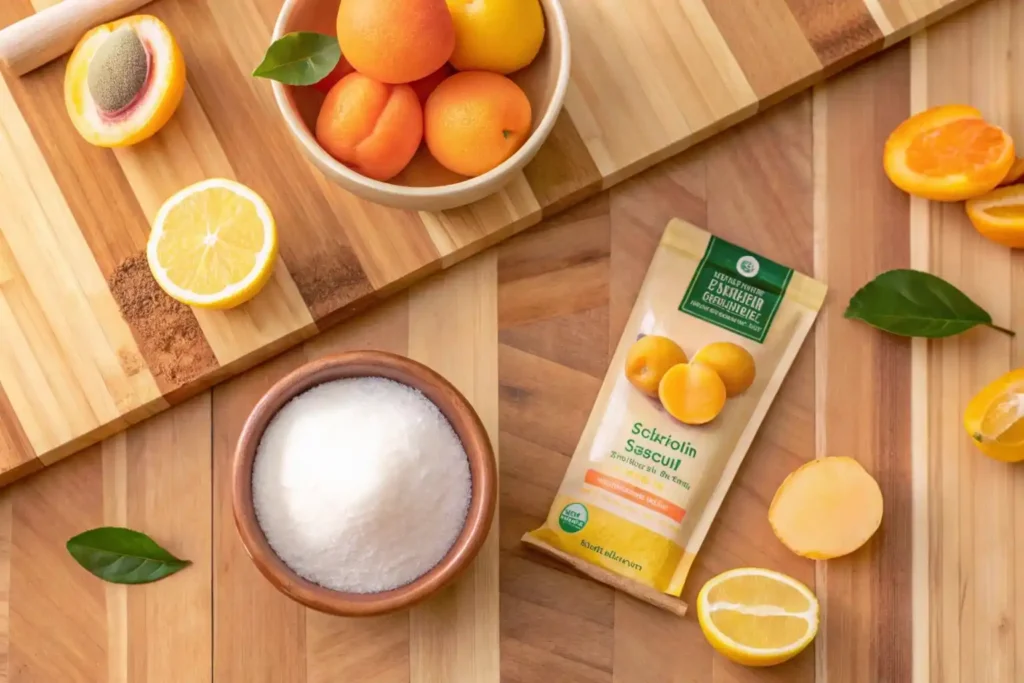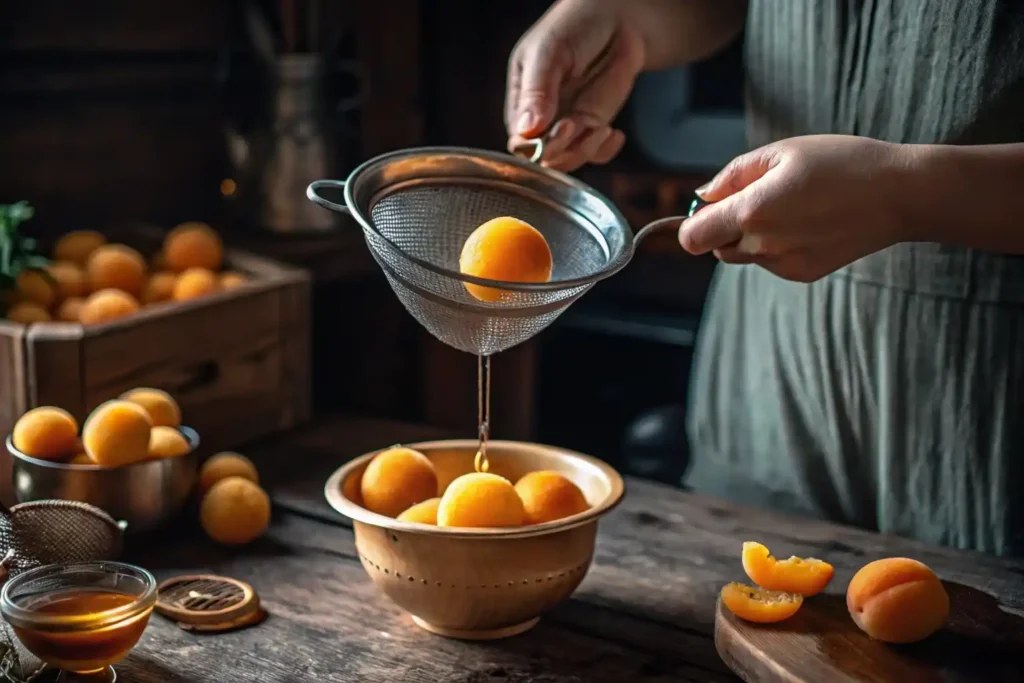Looking for an easy apricot jelly recipe to try at home? This guide will help you make a smooth, sweet spread that captures the tangy essence of fresh apricots. With just a few simple ingredients, this apricot jelly recipe is perfect for beginners and a delicious way to preserve summer’s best fruit.
While store-bought options are convenient, nothing compares to the freshness of homemade apricot jelly. This recipe ensures you control the ingredients, avoid preservatives, and customize the sweetness to your liking. Plus, there’s something deeply satisfying about filling jars with your own creation.
Table of Contents
Ingredients for the Perfect Apricot Jelly Recipe
When starting any apricot jelly recipe, your ingredients are everything. Fresh apricots, sugar, and pectin are the stars of this simple recipe. For the best results, always choose ripe fruit with a vibrant color. This ensures your homemade apricot jelly recipe delivers bold, natural flavors in every jar.
1. Fresh Apricots
The star of the show, fresh apricots provide the natural sweetness and tartness that make this jelly so special. When selecting apricots:
- Opt for ripe or slightly overripe fruit for maximum flavor and natural sugars.
- Look for apricots that are firm yet yield slightly to pressure, with a vibrant orange hue and minimal blemishes.
- Avoid overly mushy or green apricots, as they may affect the flavor or yield.
Tip: You don’t need to peel the apricots! Their skins add natural pectin and color to the juice, which enhances the jelly’s overall character.

2. Granulated Sugar
Sugar is essential not just for sweetness but also for preserving the jelly and helping it set. The standard ratio for apricot jelly is about one cup of sugar for every cup of juice. If you prefer a less sweet version, low-sugar pectin can be used as a substitute.
Pro Tip: The amount of sugar can influence the jelly’s texture. Reducing sugar too much may result in a runny jelly, so balance is key!
3. Pectin
Pectin naturally thickens the jelly and helps it set to the right consistency . You can use powdered or liquid pectin, however, make sure to follow the package instructions carefully, as they may vary. While apricots naturally contain some pectin, adding extra ensures a firm and reliable set.
Substitution Idea: Want to skip store-bought pectin? You can extract natural pectin by boiling apple peels and cores and adding the liquid to your apricot mixture.
4. Water
Water is primarily used during the initial simmering stage to help extract the juice from the apricots. Although only a small amount is needed, it is essential because it ensures the fruit softens evenly. Furthermore, it prevents the apricots from scorching in the pot during cooking.
5. Optional Ingredients
- Lemon Juice: A splash of lemon juice can enhance the flavor by adding a bright, zesty note while also balancing the sweetness. It also helps maintain the jelly’s vibrant color.
- Butter: Adding a small amount (about 1/4 teaspoon) of butter can reduce foaming during the boiling process, making the jelly easier to skim and pour into jars.
Discover more creative ways to use apricots in your recipes with this helpful guide: Unique Ideas for Apricot Jelly.
How to Make Apricot Jelly – Step-by-Step Recipe
This apricot jelly recipe is straightforward and easy to follow. From preparing fresh apricots to cooking the jelly to perfection, every step is designed to make your homemade jelly shine. Begin by washing your apricots and simmering them with water to create the base for your jelly. The beauty of this homemade apricot jelly recipe is that it’s simple yet yields professional-quality results.
Preparing the Apricots for Your Jelly Recipe
- Wash and Chop:
The first step in this apricot jelly recipe is to wash and chop fresh apricots. Once chopped, they’ll be simmered to release their natural juices. - Simmer the Fruit:
- In a large stockpot, combine the chopped apricots with 1 cup of water.
- Bring the mixture to a boil over medium-high heat, then reduce the heat to a simmer.
- Cook for 10–15 minutes, stirring occasionally, until the apricots soften and release their juices.
Tip: Don’t worry about peeling the apricots; the skins will be strained out later, and they contribute to the flavor and natural pectin.
Extracting the Juice
- Strain the Mixture:
- Use a jelly bag or line a fine mesh strainer with cheesecloth. Place it over a large bowl.
- Carefully pour the cooked apricot mixture into the strainer.
- Let It Drain Naturally:
- Allow the juice to drip through the strainer for several hours or overnight. Avoid pressing or squeezing the pulp, as this can make the jelly cloudy.
- Measure the Juice:
- Strain the juice completely, measure out 3 ½ cups. If you don’t have enough, you can add a little water to reach the required amount.
Preparing the Jelly Mixture
- Combine Juice and Pectin:
- Pour the measured apricot juice into a clean stockpot.
- Sprinkle 1 package of powdered pectin (or 6 tablespoons) over the juice and stir until fully dissolved.
- Add Butter (Optional):
- Add 1/4 teaspoon of butter to reduce foaming during the boiling process.
Cooking and Setting the Apricot Jelly Recipe
- Bring to a Boil:
- Heat the juice and pectin mixture over medium-high heat, stirring constantly.
- Bring it to a full rolling boil—a boil that doesn’t stop bubbling when stirred.
- Add Sugar:
- Quickly add 5 cups of granulated sugar to the boiling mixture, stirring to dissolve completely.
- Return the mixture to a rolling boil and boil for exactly 1 minute, stirring continuously.
- Check the Consistency:
- Remove the pot from heat and perform the “gel test.” Place a small spoonful of jelly on a chilled plate. If it wrinkles slightly when pushed with your finger, it’s ready.
Explore more tips and tricks to perfect your jelly in this detailed apricot jelly canning guide.
Tip: If the jelly doesn’t set, you can reboil it with additional pectin.
Canning the Jelly
- Prepare the Jars:
- Sterilize 6–7 half-pint jars and their lids by boiling them in water for 10 minutes. Keep them hot until ready to use.
- Ladle the Jelly:
- Use a ladle and a funnel to pour the hot jelly into the sterilized jars, leaving 1/4 inch of headspace.
- Wipe the rims clean with a damp cloth to ensure a good seal.
- Seal the Jars:
- Place the lids on the jars and screw the bands on until they are fingertip tight.
- Process in a Water Bath:
- Place the jars in a boiling water canner, ensuring they are covered by at least 1 inch of water.
- Process for 10 minutes for pint jars or 5 minutes for half-pint jars (adjust for altitude if necessary).

Cooling and Storing
- Cool the Jars:
- Carefully remove the jars from the canner and place them on a towel. Let them cool undisturbed for 12–24 hours.
- Check the Seals:
- Once cooled, press the center of each lid. If it doesn’t flex up and down, the jar is sealed properly.
- Store and Enjoy:
- Store sealed jars in a cool, dark place for up to a year. Refrigerate any unsealed jars and consume within 3 weeks.
Creative Ways to Customize Your Apricot Jelly Recip
One of the best things about this apricot jelly recipe is how versatile it is. You can add spices like cinnamon, blend apricots with other fruits, or even reduce the sugar for a tarter taste. No matter how you customize it, this recipe for apricot jelly is guaranteed to become a favorite in your kitchen.
1. Add Flavors to Elevate Your Recipe for Apricot Jelly
Elevate the flavor profile of your apricot jelly with simple additions:
- Vanilla Extract: Stir in 1 teaspoon of vanilla extract after cooking to add a rich, creamy note that complements the apricots.
- Almond Extract: A few drops of almond extract bring a nutty depth to the jelly, reminiscent of apricot kernels.
- Spices: Experiment with warm spices like cinnamon, ginger, or cardamom for a cozy twist. For example, a pinch of ground cinnamon can add a comforting touch to your jelly.
- Citrus Zest: Grate a bit of lemon or orange zest into the mixture to brighten the flavor and add a citrusy zing.
2. Blended Fruits: Unique Twists on Apricot Jelly Recipes
Pair apricots with other fruits to create exciting flavor combinations:
- Peach-Apricot Jelly: Mix equal parts of apricot juice and peach juice for a sweet and mellow jelly.
- Apricot-Raspberry Jelly: Add a handful of raspberries to the simmering apricots for a vibrant, tart flavor and ruby-red hue.
- Apricot-Plum Jelly: Plums bring a rich, tangy taste to the jelly that balances the apricot’s sweetness beautifully.
3. Reduce the Sugar
If you prefer a less sweet jelly or need a diabetic-friendly option:
- Use low-sugar pectin, which is specifically designed to work with reduced sugar levels.
- Replace sugar with natural sweeteners like honey or agave syrup. Keep in mind that this may slightly alter the texture and taste.
- For a tart version, reduce sugar and enhance the flavor with a splash of lemon juice or zest.
4. Experiment with Texture
While traditional jelly is smooth, you can add texture for a twist:
- Stir in small pieces of cooked apricots before ladling the mixture into jars. This creates a jelly-jam hybrid with a bit of fruit in every bite.
- Mix in finely chopped nuts, like toasted almonds, for a crunchy element.
5. Explore Creative Uses for Your Jelly
Apricot jelly isn’t just for toast! Use it to enhance a variety of dishes:
- Meat Glaze: Brush apricot jelly onto roasted chicken, pork chops, or ham during the last few minutes of cooking for a glossy, caramelized glaze.
- Cheese Pairings: Serve apricot jelly alongside brie, goat cheese, or sharp cheddar on a charcuterie board.
- Pastry Filling: Use it as a filling for thumbprint cookies, Danish pastries, or turnovers.
- Cocktail Mixer: Stir a spoonful of jelly into sparkling water, champagne, or cocktails for a fruity kick.
6. Create Gift-Worthy Variations
Make your apricot jelly a standout gift by customizing it with unique flavors or packaging ideas:
- Infused Jelly: Add fresh herbs, like thyme or rosemary, during cooking, and strain them out before canning. This creates a savory-sweet jelly ideal for gourmet gifts.
- Decorative Jars: Dress up your jars with handwritten labels, fabric lids, or twine bows for a personal touch.
FAQs About Apricot Jelly Recipe and Variations :
1. What is the difference between apricot jelly and preserves?
The primary difference lies in texture and preparation. Make apricot jelly by straining fruit juice, which results in a smooth and clear spread with no fruit pieces. Apricot preserves, on the other hand, not only contain chunks of apricot fruit but are also suspended in a thick syrup. As a result, they offer a more textured and fruit-forward experience.
2. What is apricot jelly made of?
Apricot jelly is typically made from a few simple ingredients:
- Fresh apricots
- Sugar (for sweetness and preservation)
- Water (to help extract juice from the fruit)
- Pectin (to help the jelly set properly)
Some recipes may also include lemon juice for added acidity and flavor balance.
3. What does apricot jelly taste like?
Apricot jelly has a sweet, tangy, and slightly tart flavor, capturing the essence of ripe apricots. Its taste is bright and fruity, making it a versatile spread for both sweet and savory dishes.
4. Why put kernels in apricot jam?
In traditional recipes, Some recipes add apricot kernels to apricot jam for their unique, nutty, almond-like flavor. The kernels are often tied in a cloth and simmered with the jam to infuse their flavor before being removed. However, care must be taken since apricot kernels contain amygdalin, which can release small amounts of cyanide when consumed in large quantities.
For a healthier option, look for low-sugar or no-added-sugar varieties of any of these spreads.
Conclusion
Making homemade apricot jelly is a rewarding experience that captures the sweet-tart essence of summer in a jar. From carefully preparing the apricots to customizing the flavor with creative additions, this versatile spread is as enjoyable to make as it is to eat. Whether you’re spreading it on toast, glazing meats, or gifting a jar to a friend, apricot jelly is sure to bring smiles and delicious moments.
Ready to explore more ideas? Check out delightful variations of apricot jelly recipes to elevate your creations and make them truly unique.
Now that you know how to make your own apricot jelly, why not try it yourself? Gather your ingredients, grab a few jars, and start cooking! Don’t forget to share your creation with loved ones—or keep it all for yourself. Either way, this recipe is bound to become a family favorite!
